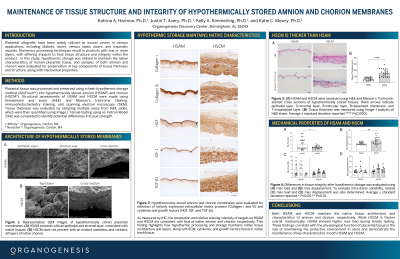Laboratory Research
(LR-017) Maintenance of Tissue Structure and Integrity of Hypothermically Stored Amnion and Chorion Membranes
Friday, April 28, 2023
7:15 PM - 8:30 PM East Coast USA Time

Justin Avery, PhD – Scientist II, Organogenesis; Kelly Kimmerling, PhD – R&D Manager, Organogenesis; Katie Mowry, PhD – VP R&D, Organogenesis
Introduction: Placental allografts have been well-established as wound covers in various applications including diabetic ulcers, venous stasis ulcers, and traumatic wounds. Numerous processing techniques are utilized to produce products with one or more layers, with differing impacts to tissue structure and integrity. In this study, a method aimed at maintaining the native characteristics of native placental tissue was utilized and samples were evaluated for preservation of key components of tissue thickness and structure and mechanical properties.
Methods: Placental tissue was processed and preserved using a fresh hypothermic storage method (AlloFreshä) into hypothermically stored amnion (HSAM†) and chorion (HSCMº). Structural assessments of HSAM and HSCM were made using hematoxylin and eosin (H&E) and Masson’s trichrome staining, immunohistochemistry, and scanning electron microscopy (SEM). Tissue thickness was conducted by sampling multiple areas from H&E slides, which were quantified using ImageJ. Tissue integrity differences between HSAM and HSCM were evaluated using ultimate tensile strength, Young’s Modulus, suture retention load, and displacement.
Results: HSAM and HSCM maintained tissue structures characteristic of native placental membranes. HSAM maintained intact epithelial, stromal, and spongy layers, while HSCM maintained the reticular, basement, and trophoblastic layers. Immunohistochemistry revealed that both HSAM and HSCM retained expression of collagens I and III, hepatocyte growth factor, insulin-like growth factor 1, and transforming growth factor beta 1. When comparing thickness, HSCM was approximately 2.6x thicker than HSAM, which was confirmed by SEM images. Mechanical testing found HSAM had a higher tensile strength and Young’s Modulus, while HSCM had a higher suture retention load and displacement.
Discussion: Both HSAM and HSCM maintain the native tissue architecture and characteristics of amnion and chorion, respectively. While HSCM is thicker overall, mechanically HSAM showed higher tensile strength and elasticity; these findings correlate with the physiological function of placental tissues in their role of maintaining the protective environment in utero and demonstrate the maintenance of key characteristics in both HSAM and HSCM.
Methods: Placental tissue was processed and preserved using a fresh hypothermic storage method (AlloFreshä) into hypothermically stored amnion (HSAM†) and chorion (HSCMº). Structural assessments of HSAM and HSCM were made using hematoxylin and eosin (H&E) and Masson’s trichrome staining, immunohistochemistry, and scanning electron microscopy (SEM). Tissue thickness was conducted by sampling multiple areas from H&E slides, which were quantified using ImageJ. Tissue integrity differences between HSAM and HSCM were evaluated using ultimate tensile strength, Young’s Modulus, suture retention load, and displacement.
Results: HSAM and HSCM maintained tissue structures characteristic of native placental membranes. HSAM maintained intact epithelial, stromal, and spongy layers, while HSCM maintained the reticular, basement, and trophoblastic layers. Immunohistochemistry revealed that both HSAM and HSCM retained expression of collagens I and III, hepatocyte growth factor, insulin-like growth factor 1, and transforming growth factor beta 1. When comparing thickness, HSCM was approximately 2.6x thicker than HSAM, which was confirmed by SEM images. Mechanical testing found HSAM had a higher tensile strength and Young’s Modulus, while HSCM had a higher suture retention load and displacement.
Discussion: Both HSAM and HSCM maintain the native tissue architecture and characteristics of amnion and chorion, respectively. While HSCM is thicker overall, mechanically HSAM showed higher tensile strength and elasticity; these findings correlate with the physiological function of placental tissues in their role of maintaining the protective environment in utero and demonstrate the maintenance of key characteristics in both HSAM and HSCM.

.png)